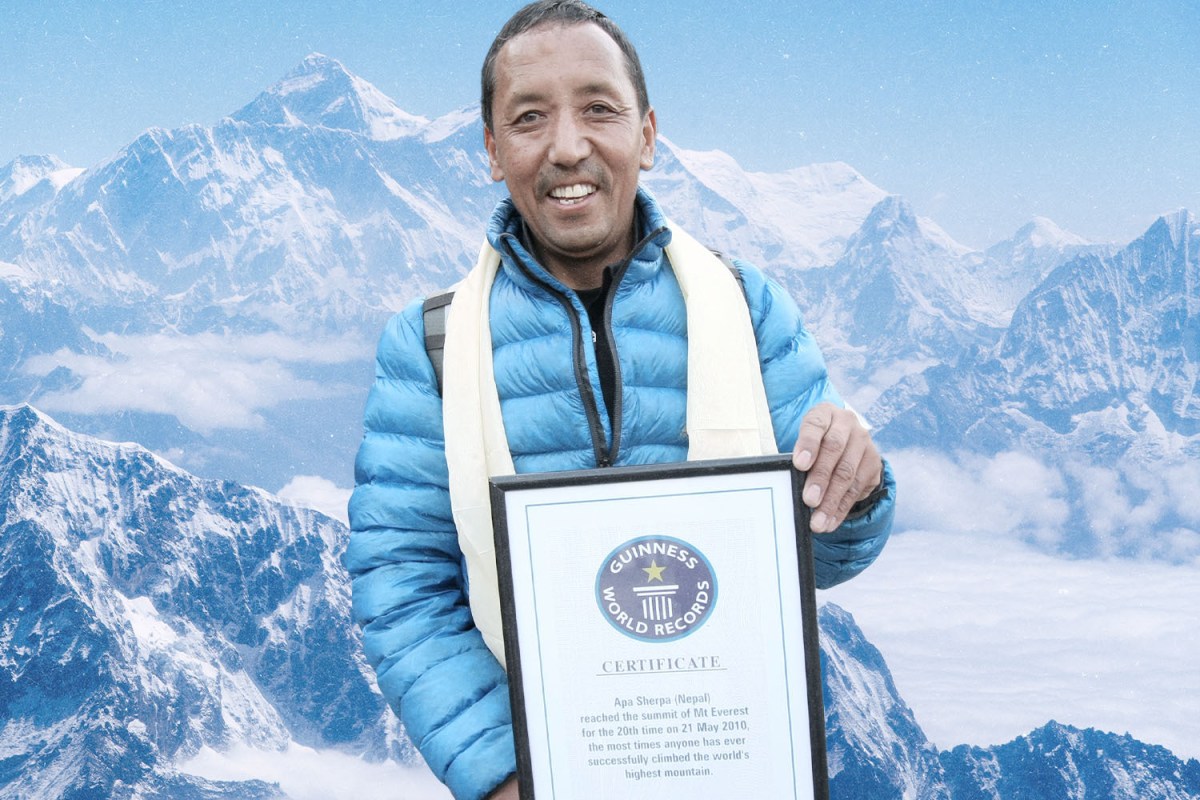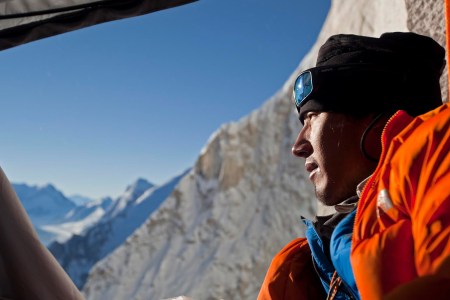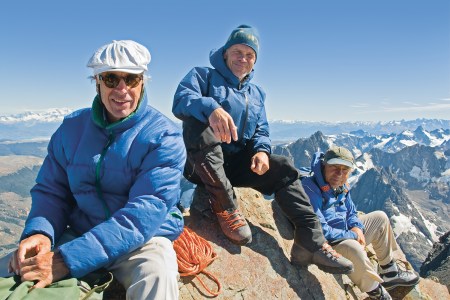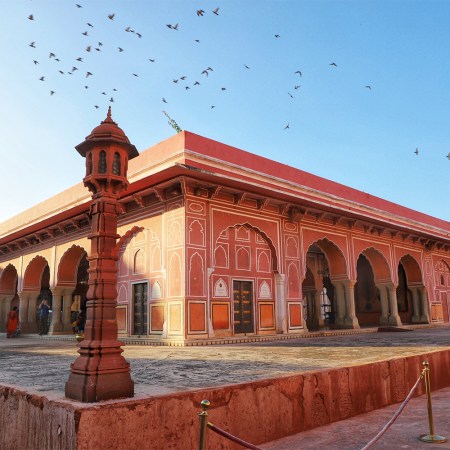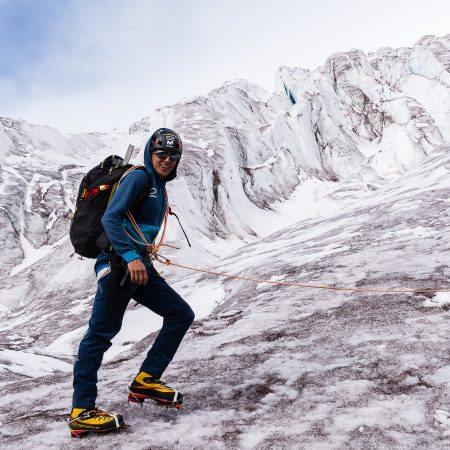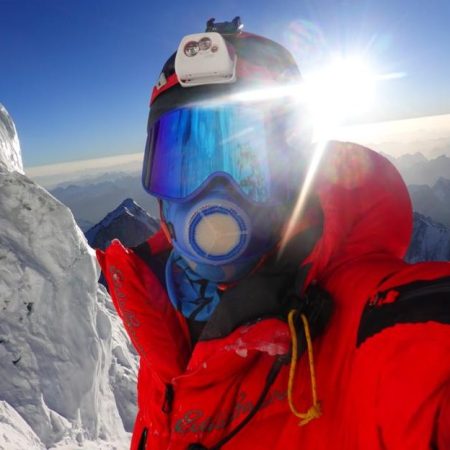“That’s three more, three more who died just this morning,” says Apa Sherpa. He doesn’t say so, but he’s referring to three of his and his wife’s relatives — three Sherpas who died on another ascent of Mount Everest, who fell into a crevasse during an avalanche on April 12 and whose bodies will likely never be recovered. “They’re all young, and all feel that they have no choice but to take these risks for the money they need to take back home.”
Although the Utah-based Apa Sherpa regularly leads groups to Everest base camp, he no longer has a desire to summit the mountain the indigenous Nepalese Sherpa people call Sagarmatha — whose instinctive, cultural understanding of and acclimatization to the mountain have made their assistance essential to any ascent. “No,” he says, very sure, “I like my life.” But then Apa has been there and — while the extreme cold at 29,032 feet up might preclude wearing it — bought the proverbial T-shirt.
Before his retirement, Lhakpa Tenzing Sherpa — renamed Apa, meaning “much-loved,” after surviving an avalanche at just three months old — held the world record for the most Everest summits, at 21. He even climbed the mountain twice one year. That record won him the soubriquet “Super Sherpa” among the hardcore climbing community. But he’s not so enamored of keeping score himself.
“Chasing records, that’s for Western people who do it for the adventure, not because they have to,” says the affable, good-humored Apa.
Apa Sherpa’s faintly embarrassed to say so, especially this year, the 70th anniversary of the first summit of Everest, by Edmund Hillary and Tenzing Norgay in 1953, but “it doesn’t take many ascents of Everest for it to lose its interest. People ask what I most enjoyed about climbing, but really that kind of climbing isn’t enjoyable. Every morning you set off not sure whether you’ll ever make it back down.”
Indeed, by one count, since 1921 around 121 Sherpas have died guiding climbers up Everest. In 2014 a single avalanche killed 16 Sherpas. Apa has had his share of narrow escapes. His first summit of Everest was with the acclaimed mountaineer Rob Hall and Peter Hillary, Edmund’s son. In 1996, one of only two years over Apa’s climbing career in which he didn’t attempt the summit, Hall and seven others were killed in a blizzard, a tragedy detailed in Jon Krakauer’s Into Thin Air. On Apa’s 2006 ascent, two Sherpas he was with died, including his niece’s husband.
Jimmy Chin Remembers Shark’s Fin, The Summit That Launched Him to Stardom
After the biggest year of his career, the Oscar-winning documentarian and all-world mountaineer looks back on the climb that started it allSmall wonder then that, Apa insists, Sherpas — even the current record holder, Kami Rita, who has now climbed Everest 26 times — only do so for lack of alternatives. And it’s alternatives that Apa is trying to give them through his nonprofit Apa Sherpa Foundation, which builds and supplies schools in remote locations across Nepal. Apa only took to portering for Everest hopefuls himself when, at the age of 12, his father died and he had to abandon what schooling there was to become the family breadwinner.
“We Sherpas are suited to the work, but that doesn’t mean the work is suited to us,” he says. “It’s more that that’s the only work available, and because we don’t have access to the education that allows us to choose a different career path. We really need to do more to help this community, to change this system. Yes, there are some Sherpas who want to climb, but there are very few of them. I know Kami Rita well — we’re neighbors in our town back in Nepal — and he climbs to provide for his family. That’s all. If he was lucky enough to find a way out, as I did, he wouldn’t be climbing. And if I hadn’t found a way out I think by now I’d have summited Everest 30 or more times too.”
Working on Everest may be relatively good money — upwards of $40,000 per climb for experienced Sherpas. But it’s not exactly an occupation without hazard: It’s typically the Sherpas, historically unacknowledged, as the story of Norgay perhaps suggests, who climb each stage ahead of their Western employers, testing the way, fixing ropes and ladders, to make it that much easier for them to follow.
“It’s remarkable that when I started climbing Everest we didn’t even wear helmets,” laughs Apa. “We didn’t have internet access, satellite phones, accurate weather reports — you just had to read the sky to plan the next day. So technology has provided a leap in safety. But that means so many more people climb the mountain. It’s actually getting dangerously crowded up there now.” Apa would like the Nepalese government to limit permits to climb to around 300 per year, rather than the 1,000-plus it lucratively issues.
“There’s a lot of pressure [to ensure climbers get to the top], so I worry a lot for my friends,” he adds. “And then there is the impact of climate change. It used to be snow and ice all the way. Now there’s a lot more loose rock.”
The Playbook for a More Adventurous Life, Courtesy of “The Real Indiana Jones”
Catching up with longtime adventurer Rick Ridgeway, who recounts his best stories in the new book “Life Lived Wild”Each year sees a peeling back of layers of ice to reveal a darker side to Everest. It’s not just the tons of equipment dumped over the decades: While climbers must now have every item they take itemized and lose a $4,000 deposit if they don’t return with that checklist complete, over the last decade Apa Sherpa has led a cleanup campaign that has brought back 600 abandoned oxygen canisters, 6,600 pounds of rubbish, including parts of a crashed helicopter, and — still fresh thanks to the freezing temperatures — over 1,000 pounds of human waste. Also revealed by the retreating ice are bodies. Lots of them.
“Some get brought back, but some of them will just have to stay there because they’re too high to recover,” explains Apa. “They’re a reminder that — what with avalanches, ice walls collapsing, rapid changes of weather, rock falls — Everest is just dangerous everywhere.”
So why does Everest hold such allure? Apa Sherpa admits that he doesn’t quite get it. There are several mountains over 26,000 feet that offer a greater climbing challenge (and that’s just in Nepal) and yet none of them, he concedes, are equal to Everest.
“They’re not the highest in the world, and that’s all that matters to some,” he reckons. “Tell people, as I have, that I’m from Nepal and you’d be surprised at the number of people who have never heard of the country. Tell them Everest is there and suddenly everyone knows.”
What he would also like them to know is the plight of the people who have made climbing Everest possible for more than half a century.
“The people who hire Sherpas climb Everest because they want to,” he says. “But, as a Sherpa, if you have the choice, you don’t want to die on that mountain.”
This article was featured in the InsideHook newsletter. Sign up now.
